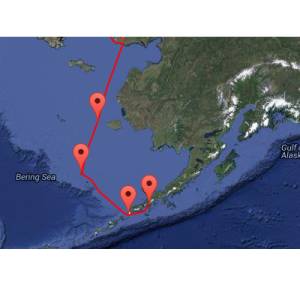
SV Traversay III - North West passage/Diverse Divers
We will be here somewhat longer and it’s hard to keep from being irritated at the delay. Even very calm people would find themselves having to tap funds of as-yet-unexplored patience in this wait for boat parts. Had they arrived in time, the last three days would have been perfect for both the haul-out and repair of Traversay and the trip towards Kodiak Island.
We’ve been fortunate to have been invited along by our friend Bob to share his nightly routine. Nearly every night he goes out on the road towards Cold Bay and checks for bears. We’ve accompanied him twice and have been rewarded with two bear sightings. Time passes quickly when you’re out watching animals going about their lives and you develop a lot of patience watching for bears in this country.
I’ve also been watching the sea otters who live in the nearby lagoon. I don't know if you know this little creature - Larry loves bears, but I think my favourite is the sea otter. At one time I was a volunteer at the Vancouver Aquarium and I could watch them forever. They lie on their backs cracking open sea urchins (their favourite food) with a rock, catch food by diving and spend a lot of time cleaning themselves. They are amiable and VERY social. They chatter away and scold each other. Sea otters like to connect themselves to each other with long chains of kelp ... sometimes a number of them are all lined up.
Of course, our sea otters at the Aquarium had been endangered by the Exxon Valdez oil spill. Sea otters (unlike seals or whales which have large quantities of blubber or fat under their hides) have an extremely luxurious and multi-layered fur coat with a layer of hair next to the skin. The coat was attractive to humans because of its warmth so they were over-hunted for a time. They froze to death once they were covered in oil and could not clean it off. The Aquarium managed to rescue and rehabilitate some of them.
It was really fun to watch them teaching their babies how to dive. Just watching was a patience-creating exercise. I was learning to dive at that time myself and it was a new skill for me in my mid-40s. I turned out to be a slow learner. Perhaps you already know this, but when you dive in a dry suit you have to expel all the air from your suit in order to go down ... for me my attempts sometimes failed and I would make a foot-first ascent up ... surrounded by air bubbles as if I were a cork popping out of a champagne bottle. The sea otter babies had similar problems and many of their first attempts were rewarded by failure and lots of bubbles!
Among divers we have met, the divers we met in Antarctica were the most patient. They wore fluffy down underwear to fight the 0.5 C water temperature. Once down, a 1-hour ascent was necessitated in order to get rid of all the air they'd added to pay for only 10 minutes of time at the bottom. They were gathering a rare little marine ascidian used to fight carcinoma.
SV Traversay is a 43 steel sloop sailed by Mary Anne and Larry and they are sailing through the North West passage from east to west, destination Victoria.

